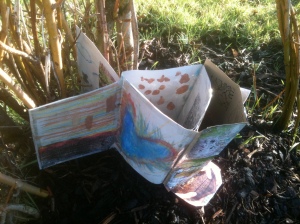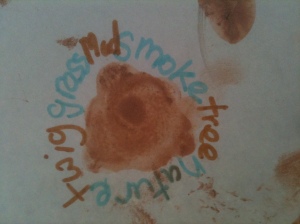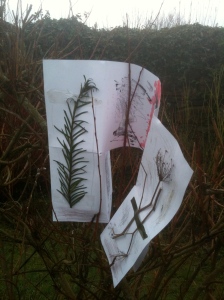Drawing With Words, Ardee Library, County Louth
November 10, 2011
Drawing with Words was a series of visual poetry workshops for families held within Ardee Library, County Louth. The poetry workshops used collage, text, and word pictures to introduce children to the imagery of poetry. The workshops continued many of the Landmarks: Nature, Art, Schools themes, namely working with nature poetry, land art, and natural materials.

Selecting lines of poetry as the starting point for art, can deepen a child’s understanding of language as a springboard for their imagination.
Equally generating descriptive word lists with children, can ignite an interest in language as a collection of experiences.
The children made artist books, bookmarks, and sculpted paper into undulating landscapes of words and drawing. They also hid greeting cards containing poetry throughout the library, with the hope that they would be found by library patrons. The children added a positive message to each greeting card, so that whoever found the card might be cheered by its gift of goodwill.
Poetry passages were suspended throughout the room for children to ‘find’. Nature photography was also introduced for the purposes of collage, and to inspire lines and shapes within the children’s artworks. Families were encouraged to work together and to embark upon their own poetic wanderings using art, words, and photography during the course of Autumn walks.
Word Pictures
March 12, 2011

 LANDMARKS: NATURE, ART, SCHOOLS
LANDMARKS: NATURE, ART, SCHOOLS
Week 5 – 28 Repeat Participants
Total Landmark Participants: 111
Location: Ardee Library, County Louth
Feedback:
“Walking art worked beautifully with the girls. Using mud enabled the children to easily create pathways throughout their art books! The Word Art also allowed the children to pinpoint exactly what they were thinking” Scoil Mhuire na Trocaire National School (Ardee, County Louth), Teacher (4/5th Class)
Word pictures are a collection of individual words which create an image both in our mind and on paper. Within the Landmarks project, children are asked to write down what they see within pictures of landscapes, magnified photographs of plants, and the characteristics of natural objects. They follow an indoor path studying these photographs and observing a variety of natural objects, writing down words as they go along. Spelling and punctuation are not important in this exercise, so that the words create a meandering path across the page. Everyone’s perspective about what they see is different. The words are a list of observations. A class can be divided into groups, and each group of children can combine their list of words to create a collaborative piece of writing.
The following words were written by students from 4/5th Class Scoil Mhuire na Trocaire, Ardee.
“Moss, purple seed, flowers growing, pinecones, bog, earth, daffodils, a ring of stone, trees, soil, mud, wind”
“Nature, ice, hut, fog”
“Adventure, mud, moss, grass, flowers”
“Twig, grass, smoke, tree”
“Pinecone, soil, green moss”
“Moss, wind, leaves, rocks”
“Earth and wind”
“Clouds, stones, trees, den, tree house”
“Wind to wind, who is me?”
The photographs on this page are books made by students from Collon National School, Ardee Educate Together and Scoil Mhuire na Trocaire.
Artist Books by Children
February 19, 2011


 LANDMARKS: NATURE, ART, SCHOOLS
LANDMARKS: NATURE, ART, SCHOOLS
Week 2 – 30 Participants
Total Landmarks Participants – 78
Location: Ardee Library, County Louth
Feedback:
“As the children created their books, the art pieces portrayed their innermost thoughts and feelings” Scoil Mhuire na Trocaire National School, Ardee, Teacher (4/5th Class)
By simply folding paper into accordion and three dimensional shapes, many different “pages” emerge for art and writing. A variety of different art materials can be used  to portray a child’s sense of nature – watercolour pastels, charcoal, oil pastels, ink stamps, photos, drawings, and samples of trees, grasses and flowers. The artist books were created by students visiting a number of different stations containing art materials. Through stamping, drawing, and collage the children worked in their own way, creating spontaneously to build up textures and assemble ideas. The small books were also an important expression of working within a library.
to portray a child’s sense of nature – watercolour pastels, charcoal, oil pastels, ink stamps, photos, drawings, and samples of trees, grasses and flowers. The artist books were created by students visiting a number of different stations containing art materials. Through stamping, drawing, and collage the children worked in their own way, creating spontaneously to build up textures and assemble ideas. The small books were also an important expression of working within a library.
Collectively the folded books create a kind of landscape of images, which can be displayed within a classroom either on a table or on a wall. The artist books can then be collectively re-positioned into many different kinds of overall shapes. By turning the books around, different pictures are revealed, so that a rotating display can be achieved within the classroom.
In The Irish Times, Michael Viney has recently written about the importance of children’s engagement with nature as fuel for their imagination (February 5, 2011). By observing and feeling nature, children generate a sense of wonder about the natural world. It is this sense of wonder that in turn encourages a receptivity to the changing states of seasons, weather, and growth. “Those who contemplate the beauty of the earth, find reserves of strength that will endure” (Rachel Carson, The Sense of Wonder). Artist books can map a child’s observations of nature, and document change. It is this contact with changing conditions that also reflects human nature. It is an opening to being in touch with a dynamic sensing of the world as ‘alive’. “It is not half so important to know as to feel” (Rachel Carson, The Sense of Wonder).
These are photos of folded books created by students of Scoil Mhuire na Trocaire and Ardee Educate Together National School.


